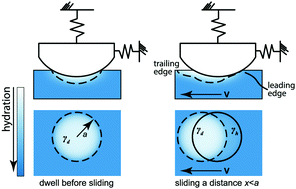Poroelasticity-driven lubrication in hydrogel interfaces†
Abstract
It is widely accepted that hydrogel surfaces are slippery, and have low friction, but dynamic applied stresses alter the hydrogel composition at the interface as water is displaced. The induced osmotic imbalance of compressed hydrogel which cannot swell to equilibrium should drive the resistance to slip against it. This paper demonstrates the driving role of poroelasticity in the friction of hydrogel-glass interfaces, specifically how poroelastic relaxation of hydrogels increases adhesion. We translate the work of adhesion into an effective surface energy density that increases with the duration of applied pressure from 10 to 50 mJ m−2, as measured by micro-indentation. A model of static friction coefficient is derived from an area-based rules of mixture for the surface energies, and predicts the friction coefficient changes upon initiation of slip. For kinetic friction, the competition between duration of contact and relaxation time is quantified by a contacting Péclet number, PeC. A single length parameter on the scale of micrometers fits these two models to experimental micro-friction data. These models predict how short durations of applied pressure and faster sliding speeds, do not disrupt interfacial hydration; this prevailing water maintains low friction. At low speeds where interface drainage dominates, the osmotic suction works against slip for higher friction. The prediction of friction coefficients after adhesion characterization by micro-indentation makes use of the interplay between poroelasticity, adhesion, and friction. This approach provides a starting point for prediction of, and design for, hydrogel interfacial friction.



 Please wait while we load your content...
Please wait while we load your content...